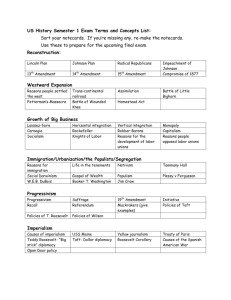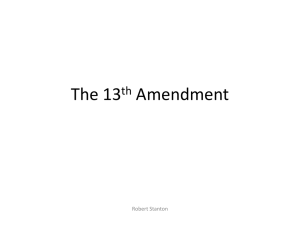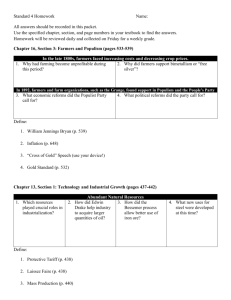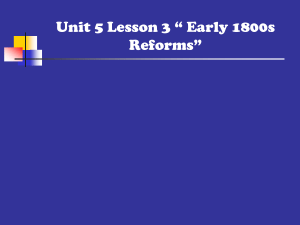USSem1
advertisement
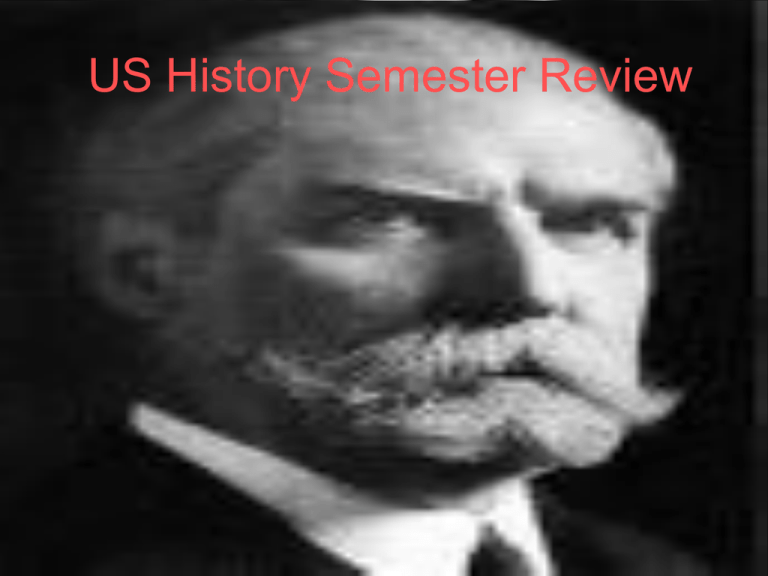
US History Semester Review Slavery and Western Expansion •popular sovereignty - government subject to the will of the people; before the Civil War, the idea that people living in a territory had the right to decide by voting whether slavery would be allowed there •Sectionalism - an exaggerated devotion to the interests of a region (loyalty to a region instead of a country) Slavery • Fugitive Slave Act – Laws requiring the return of runaway slaves and punishment for anyone who helped them − The law actually hurt the Southern cause by creating active hostility toward slavery among many Northerners. C & E Trans C & E Trans Amendments • 13th – Abolish slavery • 14th – Rights of citizenship regardless of race • 15th – Male right to vote regardless of race Civil War and Reconstruction • Emancipation Proclamation – issued by President Lincoln in 1863 to free the slaves only in Confederate States • Jim Crow laws –statutes or laws created to enforce segregation Settling the West Manifest Destiny Belief that the US was destined to spread across North America assimilate to absorb a group into the culture of a larger population homestead act method of acquiring a piece of U.S. public land by living on and cultivating it Causes of Industrialization • Abundant natural resources • Cheap immigrant labor force • High tariffs reduce the import of foreign goods • National transportation and communication networks Causes of the Growth of Big Business • Little or no government intervention (see below) • Development of pools, trusts, holding companies, and monopolies • Practices of some big businesses sometimes limited competition laissez-faire policy that government should interfere as little as possible in the nation’s economy Effects on the Workplace • Rural migration and immigration created large, concentrated workforce • Low wages, long hours, and dangerous working conditions were common in large-scale industries • First large unions formed but had little bargaining power against larger companies Assembly Line – mass production of products (introduced by Henry Ford) Social Darwinism - states that humans have developed through competition and natural selection with only the strongest surviving Gospel of Wealth - Theory that it is the duty of the wealthy to fund and create opportunities (libraries, universities, museums) to improve the lower classes Goals of the Progressive Movement • Improve society. • Protect consumers. • Improve the work place. • Stop political and corporate corruption. muckraker a journalist who uncovers abuses and corruption in a society Child Labor • Many children under 14 work to provide income for families. • The work is often dangerous and unhealthy • Child labor laws are passed, regulating time and conditions for minors to work. Effects on Politics • Seventeenth Amendment is ratified, requiring direct election of senators. • Nineteenth Amendment is ratified, guaranteeing women the right to vote. C & E Trans socialism Theory that promotes ownership of factories and farms by the people (collectively) rather than capitalists or landowners imperialism the actions used by one nation to exercise political or economic control over a smaller or weaker nation Panama Canal Canal built the US to connect the Atlantic and Pacific oceans to reduce the travel time of cargo and military ships Foreign policy set of guidelines and practices that a nation follows in its relations with other nations Monroe Doctrine Declaration by the US warning Europe to not interfere with any countries in the Western Hemisphere Isolationism policy of opposition to political or economic ties with other nations Open Door policy a policy that allowed each foreign nation in China to trade freely in the other nations’ spheres of influence Causes of World War I NATIONALISM ALLIANCE SYSTEM IMPERIALISM WORLD WAR I MILITARISM U.S. Involvement in WWI Causes: 1. Allied repayment of debt 2. German U-Boats 3. Zimmerman note – Germany promises support for Mexico to recover lost territories if U.S. enters War Effects: 1. Selective Service Act – (DRAFT) to raise an army Opportunities for African-Americans and Women in WW1 “Great Migration.” A-A move North for war work. 1916 – 1919 Women involved in war industries work. Civil Liberties in WWI 1. Espionage Act – 1917 - forbade actions that obstructed recruitment or efforts to promote insubordination in the military. 2. Sedition Act – 1918 - it was a crime to speak against the purchase of war bonds or anything disloyal against about the US Government, the US Constitution, or the US armed forces. Civil Liberties in WWI 3. Schenck v. US – 1919 - RESULT: If an act of speech posed a clear and present danger, then Congress had the power to restrain such speech. Treaty of Versailles • Britain and France wanted harsh conditions to insure Germany would not be a threat again • Conditions: – Germany accepts blame for the War – Germany has to pay reparations (cost of war) – Nine new nations created Weaknesses of the Treaty 1. Humiliates Germany 2. Ignores Russia 3. Reassigns colonies – not selfdetermination or freedom • • U.S. Senate rejects Treaty and League of Nations League of Nations is weak and ineffective The Prohibition Experiment 1920-1933 • Causes – Various religious groups thought alcohol was sinful – Need to protect the public’s health – Alcohol leads to crime, domestic abuse, and job issues – Nativism – against foreign born brewers and immigrants that used alcohol • Effects – Widespread disregard for the law – Increased smuggling and bootlegging – Birth of organized crime Prohibition Legislation: 18th Amendment bans alcohol 21st Amendment reinstates alcohol 1920’s A Changing Society Cultural Changes • Young people and women gain more independence. • The working class enjoys more leisure time. • New mass media in radio, movies, and sports develops. A Changing Society Changes for African Americans • Harlem Renaissance begins. • Great Migration during the war. • NAACP battles segregation and discrimination. A Changing Society Opposition to Change • Nativists and a new Ku Klux Klan target immigrants, Catholics, Jews, and African Americans. • Government imposes new quotas on immigration. • Fundamentalists push for traditional values. • Prohibition is implemented. Impacts in Rural Areas • Huge numbers of farm foreclosures (over 400,000 between 1929-1932) • Environment issues – Overproduction destroys soil – *Extreme drought creates ‘Dust Bowl’ • Migrant families – Farmers move West for work Dust Bowl • Creates massive relocation of Plains farmers to West Coast • Migrant farmers Franklin Delano Roosevelt • Elected President 1932 (Democrat) – landslide victory • Promised “A New Deal for the American People” • Three goals: – Relief for the needy – Economic recovery – Financial reform • Used radio broadcasts to explain goals to the people – “Fireside chats” First Hundred Days • FDR rushed through legislation to help the American people – 1st action – close the banks, send in bank examiners and new $ • RESTORE CONFIDENCE Financial Reform • Glass-Steagall Banking Act of 1933 – provide federal insurance for individual accounts (FDIC) • Federal Securities Act requires companies to: – Provide complete factual financial information about the company – Created rules for ‘insider’ information Economic Reform • Agricultural Adjustment Act – raise prices by lowering production • National Industrial Recovery Act – promote fair business practices • National Labor Relations Act (Wagner Act) – protects workers from unfair labor practices Relief for the Needy • Jobs – Civilian Conservation Corp (CCC) provided jobs for young men building roads, parks, and planting trees – Works Progress Administration (WPA) – created jobs for 8 million people in everything from construction to music More Relief for the Needy • Federal Housing Administration – government loans for home mortgages • Social Security Act provides: – Retirement insurance – supplemental insurance for retirees 65 or older – Unemployment compensation – Aid to families with children and the disabled Impacts of the New Deal 1. Deficit spending – spending more money on programs than the government receives in revenue 2. Expanding government’s role in the economy 3. Protection of workers’ rights 4. Banking and Finance Reform 5. Social Security 6. Environmental protection Sample Test Questions from the Final Exam “A house divided against itself cannot stand…I do not expect the Union to be dissolved; I do not expect the house to fall; but I do expect it will cease to be divided. It will become all one thing or all the other…” Abraham Lincoln, 1858 1. The “divided house” referred to in this speech was caused primarily by A. expansionism B. war with Mexico C. slavery D. the suffrage movement 2. The data shown in the graphs best support the conclusion that the North A. was better prepared economically to fight the Civil War. B. lagged behind the South in bank deposits. C. produced more agricultural products than the South. D. lacked several important resources to fight the war. “(Buffalo hunter) have done more in the last two years, and will do more the next year, to settle the…Indian question than the entire regular army has done in the last thirty years…For the sake of peace let them kill, skin, and sell until the buffalo are destroyed.” -General Philip Sheridan 3. What was the result of the process described in this quotation? 1. Native American Indians were granted farmland under the Homestead Act 2. The disappearance of their economic base helped drive Native American Indians onto reservations. 3. Many Native Americans moved to Eastern cities to work in factories. 4. Most Native Americans migrated to Canada to find new ways to earn a living. 4. What is the best title for this series of maps? A. Industrialization of the United States. B. Sectional Conflicts in the United States. C. Transportation Revolution in the United States. D. Moving Frontier of the United States. 5. In the late 19th century, the major argument used by labor union leaders against immigrants was that immigrants A. took jobs from United States citizens. B. contributed little to enrich American life. C. placed financial drains on social services. D. refused to assimilate into American culture 6. Supporters of literacy tests to restrict immigration would most likely favor the views of Speakers 1. A and C 2. B and C 3. B and D 4. A and B 7. The immigrants referred to by Speaker D were mainly from 1. Canada and Mexico 2. South America 3. Western Europe 4. Southern and Eastern Europe 8. The growth of big business in the late 1800’s resulted in A. a reduction in child labor. B. the elimination of the lower class. C. the widening of the economic gap between rich and poor. D. a shift in transportation investment from railroads to canals. 9. During WWI, what was the safest way to deliver men and materials to Europe? A. Men and materials were only delivered into Europe at night B. Men and materials were delivered into Europe by merchant ships that traveled in a convoy system across the ocean. C. Men and materials were delivered into Europe by plane. D. Men and materials were delivered into Europe daily by a big destroyer boat. “Public Ignores Prohibition Restrictions” “Evolution and Creation Debated in Scopes Trial” “Women Bring Change to the Industrial Workforce” 10. What do headlines such as these from the 1920s illustrate? A. Conflict between traditional and modern values B. Trend toward mass consumption of consumer goods C. Hostility of certain groups toward ethnic minorities D. Debate over the role of government in the economy 11. Which conclusion is best supported by the information on the graph? A. The level of automobile production remained constant. B. The average American family found the automobile too expensive to purchase. C. By 1929 most of the automobiles in the world were produced in the United States. D. Changes in economic conditions led to changes in automobile production. 12. Which factor contributed most to the situation shown in the cartoon? A. low tariff rates B. shortages of consumer goods C. nonregulation of banks D. creation of a national bank 13. Which region of the United States suffered most directly from the Dust Bowl? A. Southwest B. Pacific Northwest C. Rocky Mountains D. Great Plains 14. The photograph above shows a breadline in New York City during the Great Depression. Such breadlines were common during this period because A. many people had little money to buy food B. dust bowls in the West caused a shortage of wheat C. most food went to feed soldiers fighting in the Second World War D. most farmers left their farms for jobs in the cities
